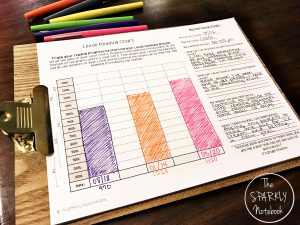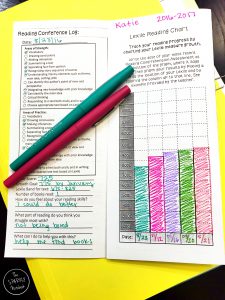“Welcome! Please come in and have a seat in my office. Make yourself comfortable. I will be with you as soon as I make my round to check on everyone else’s progress on the Chromebooks. In the meantime, go ahead and write your name on the chart and look over your slip of paper.”
In the midst of the new year goal setting mindset I had this week, I decided it’d be a good week to go ahead and have some conferences with my students about their reading lexiles and the books they should be reading. In the ideal world, I would have completed these conferences with one student at a time, and that’s what I’d like to do with time; however, for time’s sake, we met in groups.
I cannot tell you enough how much value there is in conferencing with your students. You get to talk about where they are, where they should be, set goals for them, and make a plan for how to get them there. Believe it or not, your students love you taking your time to sit down with them and help them set goals. My students were all very receptive to everything I said, and I think that conferencing with them helped them to see the genuine interest I have in seeing them achieve.
Here’s How it’s Done
I start by grouping my students very carefully. I place all scores in order from lowest to highest and group them in groups of 3-5 depending on how close their scores are from one another. I want all of my students in one group to have scores that are in the same range so their goals will all be similar.
When conferencing, I used my Reading Growth Chart and Conference Form. It’s used to track lexile scores over time. I start by pulling the data for their lexiles at the end of the previous grade if the data is available. Each student gets a small slip of paper that has their 6th grade spring lexile, 7th grade beginning lexile, and the most recent lexile from December.
The students write the dates at the bottom as well as their score. I then have them color up to where their score is on the chart provided. These charts can also be used as plot lines; however, I like for the students to get to color them; I think it’s more powerful. Plus, it makes the charts much prettier. During this step, I make sure to explain to the students the need to make sure they are coloring to where their score would go in the box and to not just color to the top of the box.
After every student in the group has their data charts completed, we talk about the trend we want to see as we look at the charts. The goal is to see growth and a pattern that is moving up. We talk about how dips in data make us human and that they are ok, but we need to strive to move forward and back up to where we need to be.
I refer the students to the brackets on the left of the chart to determine the grade level they are currently reading in. We celebrate any and all small victories we see in their data and talk about how to move forward from there.
Every group’s conversation sounds completely different because the level of scores vary.
I always make sure my students who have achieved really high lexiles understand that attaining growth will be harder for them, but it is very possible. We discuss the types of books they need to be reading and look at the lexile range they need to aim for. Once students reach a certain lexile range, it is VERY hard to find fiction books of interest at their level, and the last thing I want to do is take away the books they want to read. I always challenge them to get at least one small nonfiction higher lexile book to read prior to reading the fiction book of their choice (unless they find a good fiction book in their range).
My lower babies are going to be my non-readers, so the conversation with them is more me trying to motivate them to find a book they might enjoy to read. We look at what their lexile is, talk about what books they can read, and I usually go into an analogy for sports and reading. I talk about how I used be a rockstar on the basketball court, but I couldn’t get out there and perform well now if my life depended on it because I have not practiced in years. Reading is the same. If you don’t practice, you will not get better. I go into much more depth, am super animated for these, and work as their personal cheerleaders. These are the students who don’t have much confidence in themselves when it comes to reading. It’s my goal to show them they can do better than they think.
After we have went over their current scores, their new goals, and the books they should be trying to find, I send the students back to their desks to complete the specific goal-setting details. This is the right side of the sheet. The students think about what they can do at school and at home to achieve their lexile. They write what I can do as their teacher to help them and come up with an incentive they will get once they’ve achieved it. I then collect them to put in my binder. At the end of the year, I will make a copy for their teacher for next year and send the original home with the students.
Upon completing my round of conferences with my students based on lexiles, I plan to meet with my students who did not show any growth or who showed minimal growth independently. I want to hear why these students think they didn’t perform as well and let them determine what they can do to make sure they go up the next time they test. I will then let them choose a date for a retest. This way they have a goal and a time frame to work toward it. I am confident that this will be the boost they need to see some improvement.
If you have any questions about the process or the Reading Growth Charts, please feel free to email or message me. I love this stuff and would love to help in any way I can. You can click on the follow pictures to access the Reading Conference Charts if you are interested.
HAPPY CONFERENCING!







 Two Digital Escape Rooms for Spring Break
Two Digital Escape Rooms for Spring Break End-of-Year Reflection and Advice Infographics
End-of-Year Reflection and Advice Infographics ELA standards got you down? Check out these bundles!
ELA standards got you down? Check out these bundles!
This is genius! We set goals in my class often, but I haven’t really taken the time to conference with them individually and discuss their progress and very specific reading goals for themselves. I know it would be extremely powerful! Thank you so much for sharing!
I like how you meet with your students to review over their reading text and levels. It is important for students to have accountability. Thanks for sharing.
Jamie
Teaching Tidbits and More with Jamie